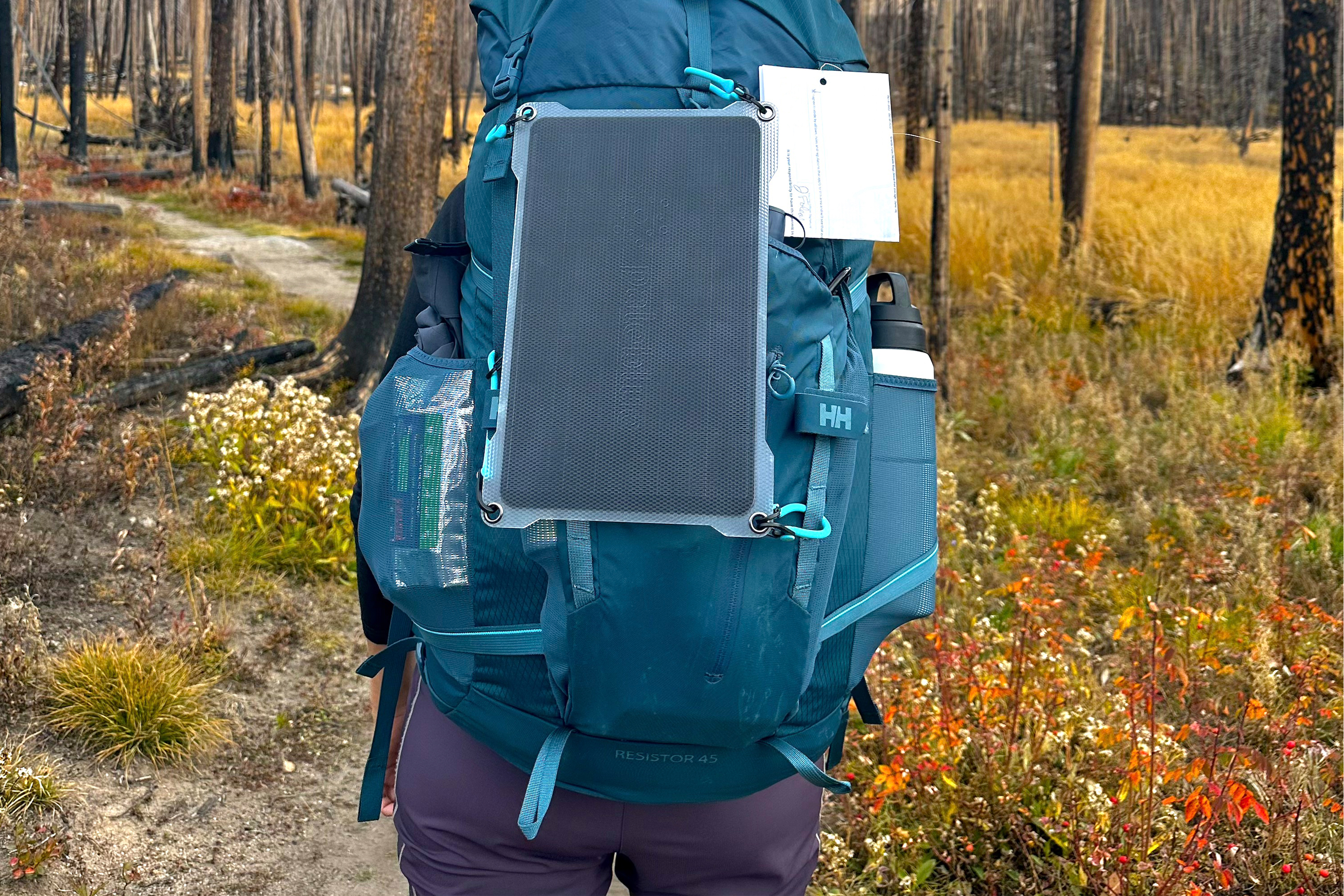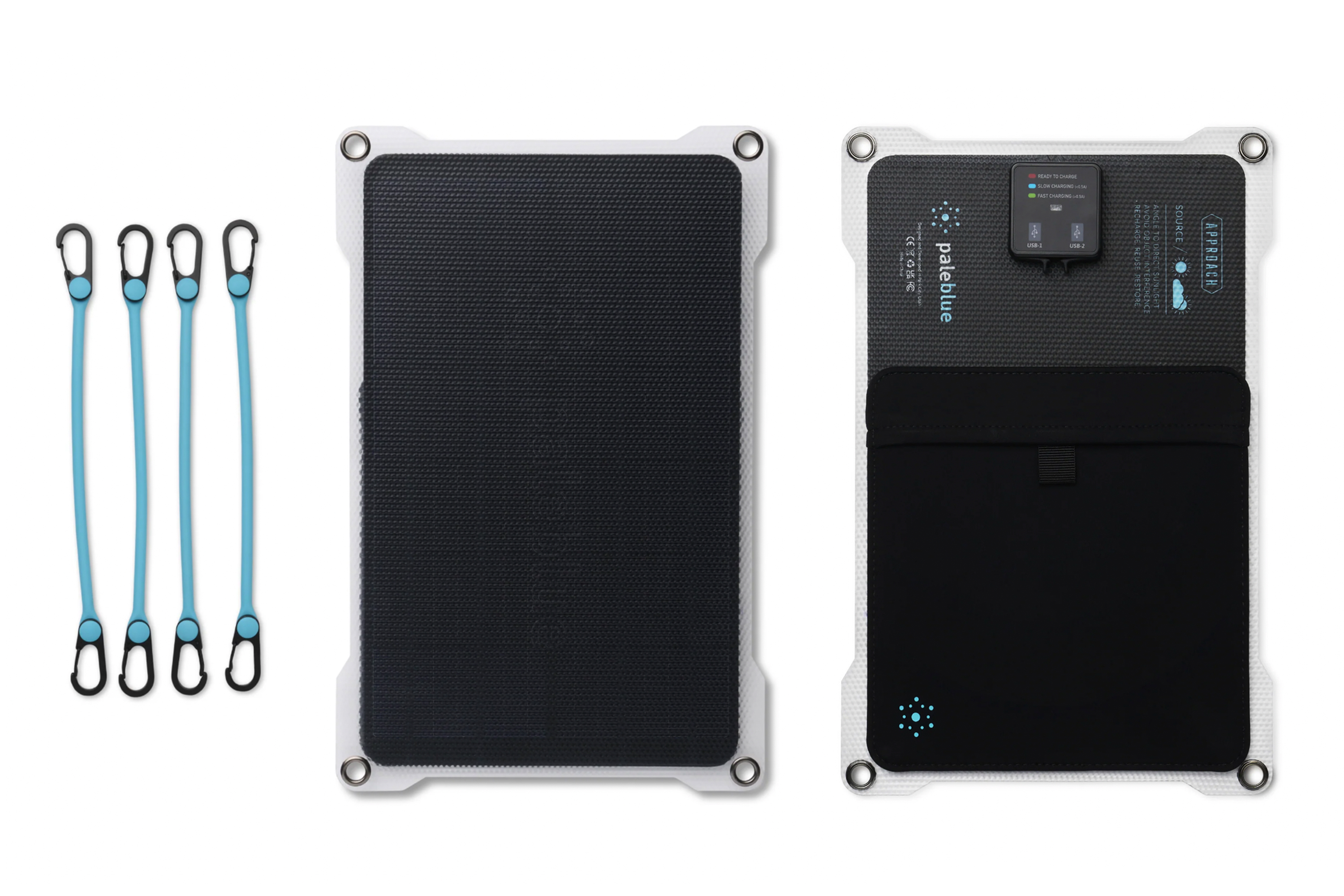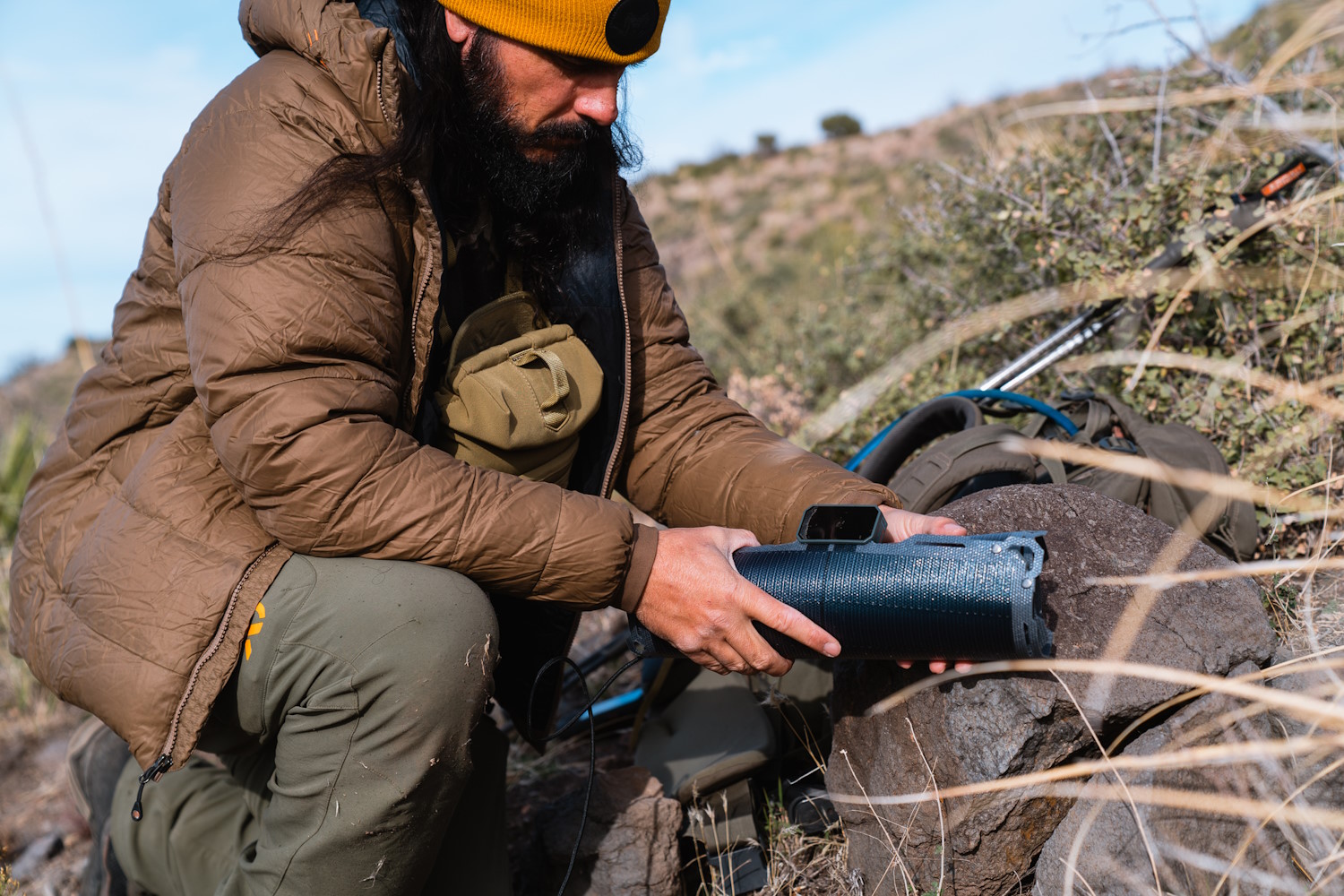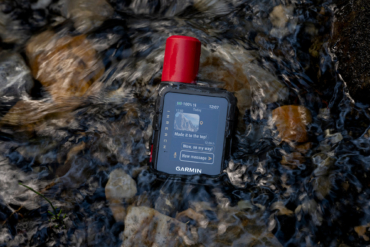It was 1 a.m., and my carbon monoxide alarm suddenly went off. The beeping was intermittent but piercing. I sprung up, opened all my windows and dug out the manual. I checked it again, still half-asleep and painfully listening. To my relief, it was only a malfunction with the unit’s battery. But, I didn’t have a replacement battery to fix the problem. So, it kept me awake all night.
Which gave me ample time to think about batteries and what they power. They’re often used in safety equipment like baby monitors and carbon monoxide alarms, GPS units, emergency radios, and a slew of other gadgets. At the campsite and on the trail, batteries are needed for headlamps, lanterns, heated clothing, and more. You’re out of luck if that stuff dies and you don’t have spare lithium batteries.
Even if you have rechargeable AA and AAA batteries like those Pale Blue Earth makes, you still need a reliable way to charge them. This makes it essential to have a high-quality solar panel when you’re camping or out on the trail. It can be hard to know when a battery is going to die — and if it’s powering an important piece of gear, that could become a serious issue.
So, when I saw the Pale Blue Earth Approach 1 & 2 Solar Panels that were designed specifically for the trail and that are loaded with useful features, I decided to give them a try. If nothing else, I figured maybe they could help me keep some extra batteries charged for the next time my carbon monoxide detector needs a spare.
In short: The Pale Blue Earth Approach Solar panels are 5V USB-A compatible solar panels for outdoor charging. The Approach 1 and Approach 2 have outputs of 7W and 21W, respectively. They weigh 11 ounces for easy transport on the trail or at the campsite. Both panels also feature a nifty utility pocket that makes it simple to store cables, rubber ties, and more. This is a solar panel built for backpackers. It’s rugged and will withstand hard use on trail.
- Dimensions: 20cm x 30cm
- Attachment ties included: Yes, 4
- Charging ports: 2 USB-A ports
- Voltage: 5V
- Max output wattage: 7W, 21W
- Claimed weight: 10.9 oz. (Approach 1), 1 lb., 11.8 oz. (Approach 2)
- Verified weight: 11 oz. (Approach 1), 1 lb., 11.4 oz. (Approach 2)
Pros
- Functions really well
- Can charge two things at once
- Biggest highlight is the rear panel utility pocket
- Included grip ties are awesome
- Charging light indicator works well to help users angle panels into full sun
Cons
- Requires attaching or leaning for setup (no stand)
- Would be nice to see an upgrade or addition of USB-C port in the future
Reviewing Pale Blue Earth Approach Panels: From Batteries to Beyond
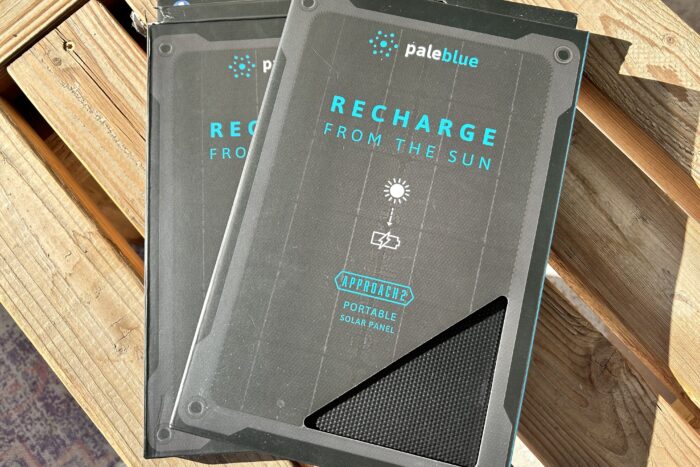
These solar panels are minimalist and simplistic. They’re flat like a hardcover book, sturdy, and generally similar in concept and design to other solar panels. What’s included in the box: the Approach solar panel with two USB ports, a charging indicator, back utility pocket, an instruction manual, and four grip ties.
Pale Blue’s Approach panels came in minimal packaging — which is important to me. They have labeled ports, and an easy-to-follow manual. They also each have four eyelets (one in each corner) that make it simple and easy to strap to a backpack (especially with those included ties).
Pale Blue Earth Approach 1 & 2 Solar Panels: In the Field
I’ve tested these panels everywhere from road trips across the state (harnessing solar power from the glaring sun on my dash) to extended backpacking trips. Pale Blue Earth’s Approach 2 has lived in my trunk for the past 6 months on long-haul drives, weekend hikes, and random excursions up to the mountains.
And while I loved having the trifold 21W Approach 2, the Approach 1 (7W max) is much more my size and speed. The Approach 2 was overkill for most backpacking scenarios.
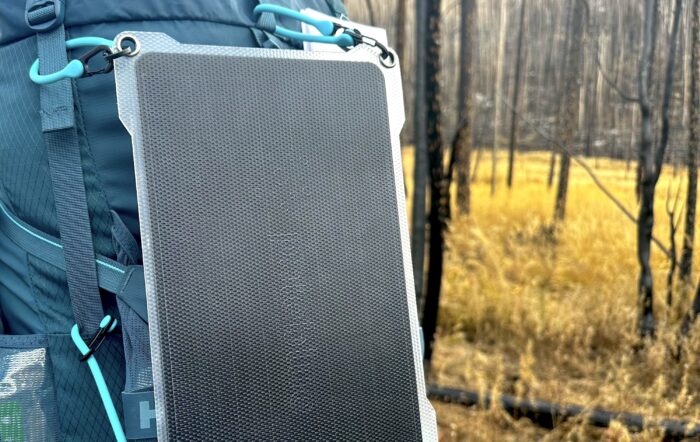
Storage & Organization
I cannot say this enough: the integrated utility pockets are why I’d buy these panels over others. We’ve all struggled with where to put our phones while charging. In an attached phone pocket, hip belt, side pocket, or pack brain? Will your cable reach? Is it easy to access and secure?
Pale Blue Earth’s pockets protected my phone from sun exposure, as well as general abrasion and weather protection on the trail. It is genius. Some other solar panels have similar features. With minimal fabric and weight, this design offers a designated place to store not just cables, but also your phone or device while charging, keeping it out of the sun and secure. The pocket on the Approach panels can fit an iPhone 14 Pro.
Mind the Gaps
The only difference between the design of the Approach 1 versus the 2 are half-inch gaps between the hinges where it folds. This caught my eye compared to other brands where the panel sides are flush at the joints. The gaps give the panels much better articulation if you hang the 21W tri-panel over a larger pack or duffel.
On the ground and for other setups, the jury’s still out. I could see those as a potential failure point.
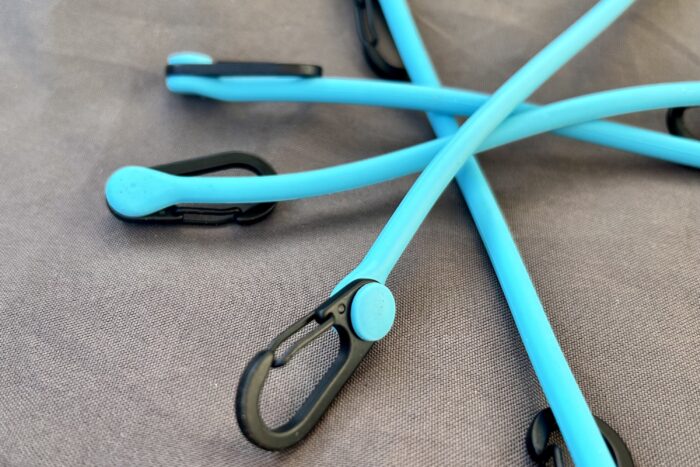
Tie-Down Options
I found the grip ties easy to use, manipulate, twist, and stretch (without breaking). I made sure to secure them to different loops of fabric, and clip them on in different ways to see how they fared with various methods. They were fairly easy to secure on half a dozen different packs I had in testing. Simply, the ties work well. I haven’t had one snap yet, even when using them in temperatures below 0 outside.
If you lose one, the eyelets on the corners of the panel also fit Nite Ize ties, smaller carabiners, or even shoelaces if you don’t have anything else.
Charge Times
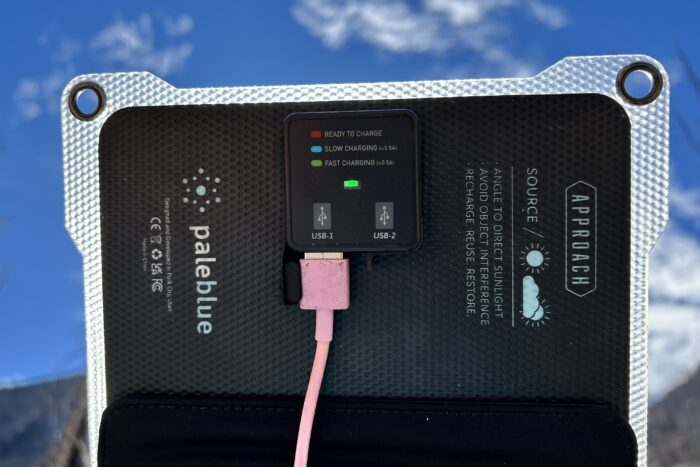
I let my phone get down to 50% battery, plugged it into the 7W panel, and set it in direct sunlight for optimal charging. In 34 minutes, it had charged to full capacity. For pale blue, that’s >0.5A charging.
I never tested this from 0% charge, as I was usually using my phone for navigation, weather, photos, and other necessary functions. And I was never sure I’d have sunlight to charge with. So, I used the panels to ensure my phone was always topped off. They did a stellar job at that.
I also used a USB-C-to-USB cable to use the larger 20W panel to keep my computer charged through a full afternoon working outside and off grid.
Comparisons
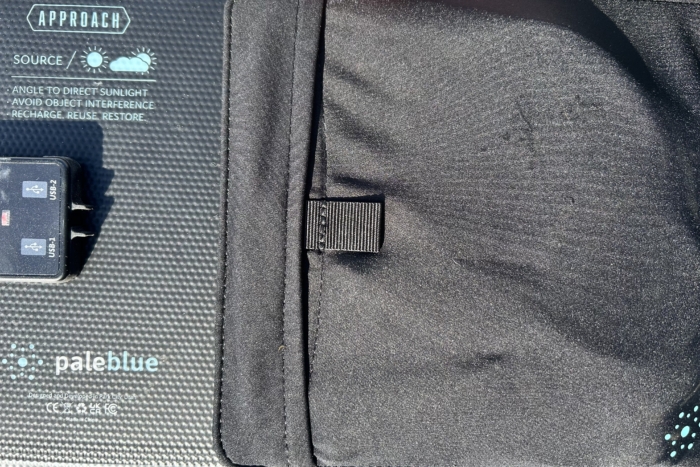
I did compare the Pale Blue Approach to two existing similar-size solar panel units on market: the Goal Zero Nomad and BioLite Solar Panels (5 and 10). For both, I liked the Pale Blue’s functionality a lot better. I don’t understand and have rarely used the metal “kickstand” on other solar panels. They require a very flat surface to work well. I also don’t prefer BioLite’s units as they’re heavier.
In terms of power generation, Pale Blue and its competitors were pretty close. For maximum charging efficiency, EcoFlow’s panels still take the win.
Durability
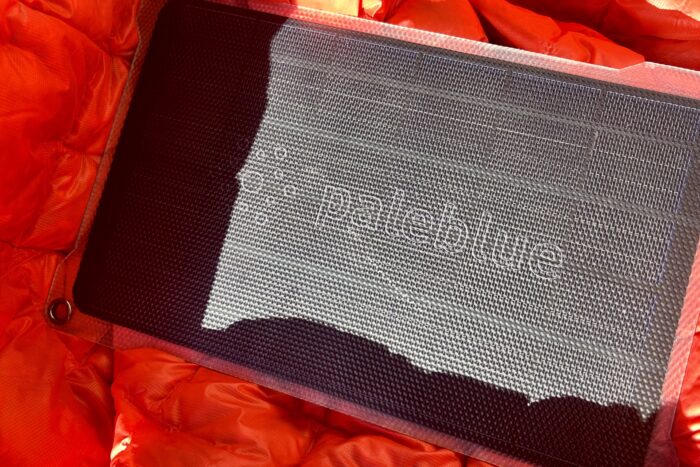
After my first 2 months with these panels, I accidentally scratched the face of my Approach 1. It probably happened on a weekend backpacking trip through some dense trees. It hasn’t affected the functionality, but in theory, any damage means a slight reduction in energy and efficiency. Otherwise, the panel is rigid and durable and has held up well. But when deciding where to store or strap it, keep scratches and face damage in mind.
Approach Solar Panels: Conclusion
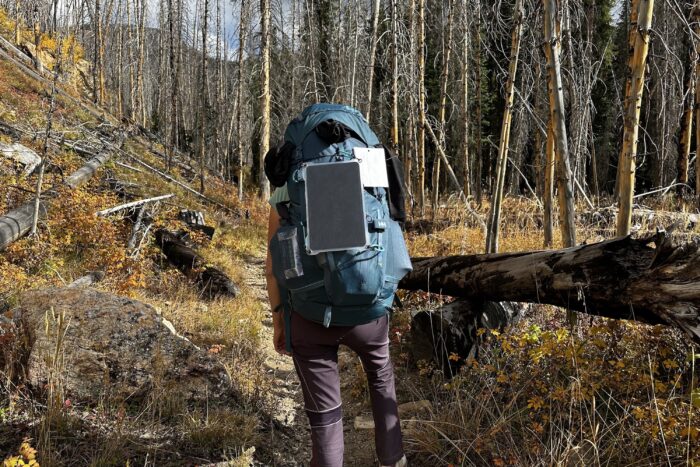
Solar panels aren’t new. But Pale Blue Earth’s design is refined and refreshingly simple. In my opinion, the device pocket is a nugget of gold in the design. The charging ports and performance also easily stack up to big competition like Goal Zero.
If you are going off grid, especially if backpacking or thru-hiking, these solar panels would be a stellar companion. The Approach 1 and 2 both worked great for me in testing, though my preference for portability and weight is the Approach 1. For overlanders and RVers, you still might be better off with bigger-output beefier options from brands like Jackery.
Factoring in the size and specs, the value is pretty awesome as well. Pale Blue Earth’s 7W-output Approach 1 Panel will run you $80, while the Approach 2 panels with 21W output are $150 (the same price as Goal Zero’s 20W Nomad). Overall, Pale Blue Earth is spot on in pricing compared to its close competitors.
However, I think Pale Blue has a huge leg up in design.
